Planking while pregnant. Is it safe? Should you do it?
After reading this post, you will learn:
- If you should plank while pregnant,
- The 20 best plank variations you can do during pregnancy,
- How long you should hold a plank for,
- and more
Okay, let’s get started.
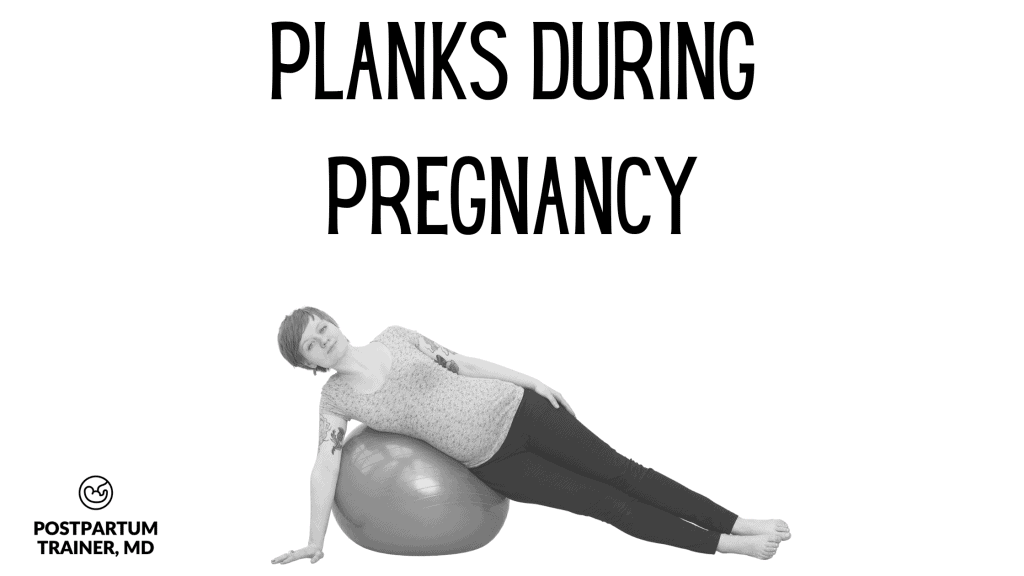
Are planks safe during pregnancy?
Yes, planks are safe to do while you are pregnant if
- you do them correctly, and
- you have spoken to your doctor and she/he has cleared you to exercise during pregnancy
Depending on how far along you are, you may have to modify the plank variation to find one that is comfortable for you.
As with all exercise during pregnancy, you should not perform any exercise that you are not comfortable performing or ones that cause you pain or discomfort.
Should you plank on your elbows or hands?
High planks, which refers to the plank performed with your arms straight and hands flat on the floor, are harder than the low plank, which is performed with your elbows bent on the floor.
If you have a strong core and have maintained your level of fitness throughout pregnancy, you will be able to plank on your hands.
If you have never trained your abdominal muscles prior to pregnancy you should start with the low plank, on your elbows.
How long should beginners hold a plank?
As a beginner, you should try to hold a plank for 15 seconds. After which, you can take a break for 1 minute, before doing another set of planks for 15 seconds. You can continue doing 15-second sets with 1-minute breaks for a total of 3-5 sets.
Over time, you can slowly build your way up to 20 seconds, 25, and then 30 seconds.
Next let’s talk about different types of planks you can do.
20 Safe Modified Planks For Pregnancy
In this next section, I’ll go over a few different variations you can do for each trimester.
In general, the variations should get less challenging the farther along in pregnancy you are.
*Don’t forget to always check in with your doctor first before doing any of these.*
When performing any type of plank – it is absolutely important that you maintain a proper pelvic alignment.
You want to avoid getting into an anterior pelvic tilt.
This is when your low back arches excessively. Here’s how it looks.
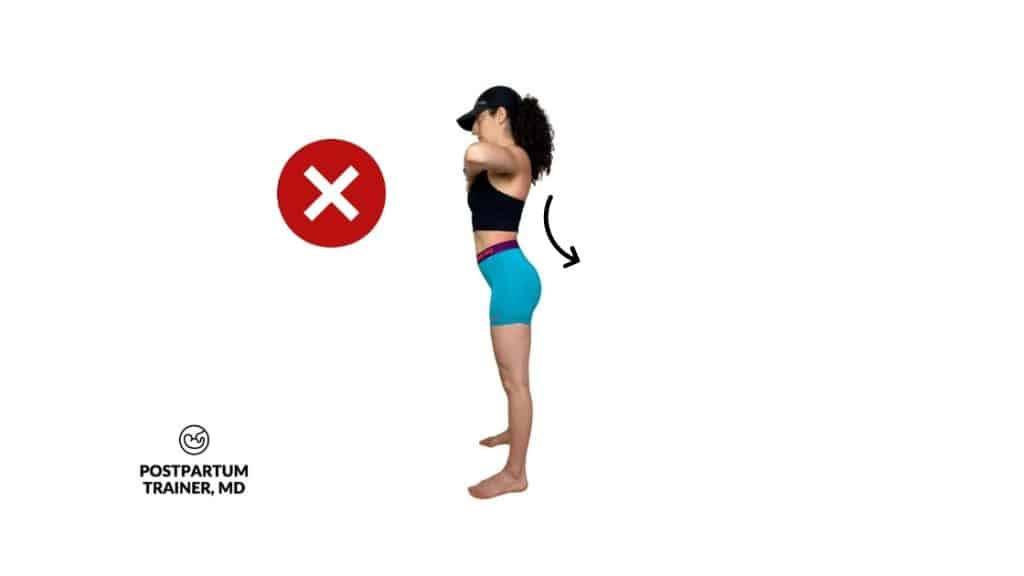
This position prevents you from properly engaging your core muscles, and will increase your risk of developing back pain in pregnancy.
You can prevent this by:
- Always squeezing your glutes
- Keeping your core engaged
- Focusing on maintaining a neutral (or even rounded) spine throughout the exercises
Okay let’s get to the plank exercises.
planks During The 1st trimester
In the first trimester, you should be able to get into most of the plank positions comfortably.
With that said, if you have never done a plank before, take your time and always start with the least challenging variation.
I.e. feel free to use some of the 2nd trimester and 3rd-trimester variations in the first trimester if you are just starting out.
Okay, let’s get started.
Low planks
We will start with the basic variation – which I will call the low plank. This is the variation done on your elbows/forearms.
Here’s how to do it.
- Get into a quadruped position on your hands and knees.
- Now, straighten one knee out behind you.
- Then straighten the other knee out behind you.
- Now, bend one elbow down followed by the other elbow.
- Keep your core and booty muscles engaged so that your back remains neutral and does not pike or sag.
Here is how it should look:
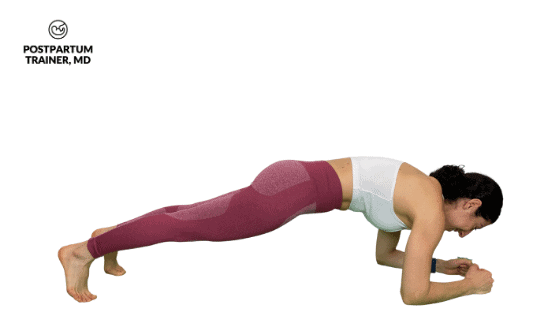
High planks
High planks are a more challenging version of the standard low plank.
Here’s how to do it.
- Get into a push-up position with your hands directly underneath your shoulders, with your elbows straight.
- You can keep your feet together or slightly apart.
- Next, be sure to keep your core and booty muscles engaged so that your back remains in a neutral position and does not pike upwards.
- Also, do not let your hips sag. There should be a straight line from shoulders to your heels.
Here is how it should look:

Up and down planks
In the up and down plank, you will transition from a low to a high plank. This variation is quite difficult. You will definitely feel the burn in your abs and arm muscles.
This exercise will definitely challenge your ability to maintain a strong core while moving.
Here’s how it looks:
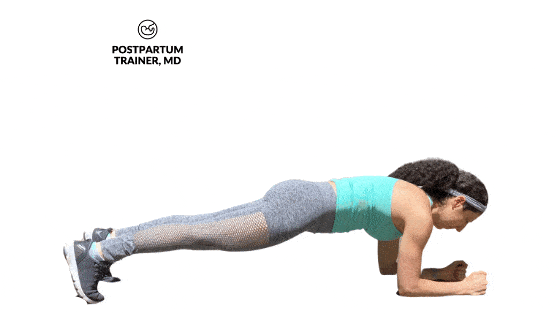
- Start in a low plank position.
- Keep your core and glute muscles engaged.
- Now you are going to transition into a high plank position by extending one arm at a time.
- Try not to move side to side while getting into the high plank position.
- Do not let your hips sage or pike up into the air. You want your back to remain neutral.
- Now you will return to the low plank position by bending one elbow at a time.
To make this exercise easier, feel free to perform it from your knees, or you can widen your feet.
Side planks
The side plank is a great exercise to strengthen your transverse abdominal muscles and your obliques.
What’s great about the side plank is that you can easily increase or decrease the difficulty.
Here’s how it looks:
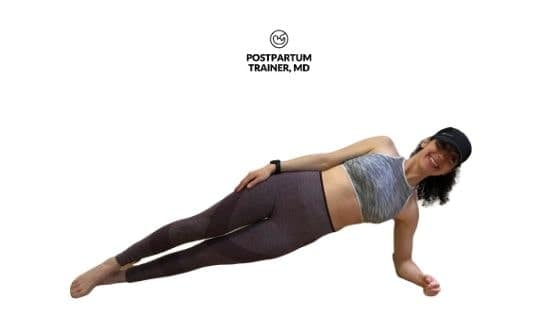
- Get into a side lying position with your legs straight out, hips extended.
- Prop yourself up on your forearm.
- Now, engage your core and squeeze your booty muscles as you elevate your hips off the floor.
- Stack one foot on top of the other while keeping a neutral spine.
- The only two points of contact on the floor should be your feet and your forearm.
To make this exercise easier, place the bottom knee on the ground.
To increase the difficulty of this exercise, prop yourself up into a high plank, with your arm straight.
Walking plank
Walking planks are a fun exercise that will challenge your core while strengthening your upper body.
Here’s how it looks:
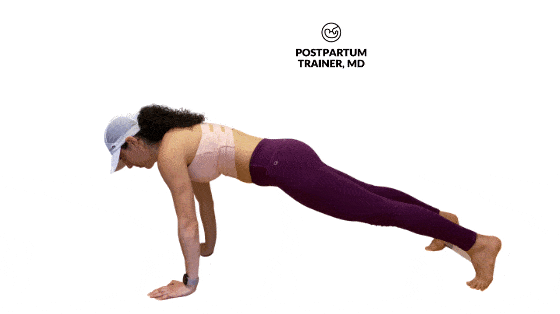
- Assume a tall plank position.
- Posteriorly tilt your pelvis and maintain a neutral spine.
- Now, pick up your left hand and place it out to to your left side, wider than shoulder-width, without bending your elbow.
- As you are doing that, pick up your left leg, and also step it out to the left.
- Then, lift your right hand and right leg and bring them closer to the left hand and foot that you stepped out.
- Continue doing this until you have taken 2-3 steps to the left side.
- Now walk to the right side by taking 2-3 steps to the right.
Plank with arm raise
The plank with arm raise can be done in the high plank or low plank position and will teach you how to engage your core while moving your upper body.
Here’s how it looks:

- Get into a high plank or low plank position.
- Be sure to posteriorly tilt your pelvis.
- Now lift one hand off the floor and reach it out in front of you.
- Hold this position for 3 seconds.
- Bring your arm back down to the ground and repeat using the other arm.
Plank with leg raise
The plank with leg raise can also be done in the high plank or low plank position and will teach you how to engage your core while moving your lower body.
Here’s how it looks:

- Get into a high plank or low plank position.
- Be sure to posteriorly tilt your pelvis.
- Now lift one leg off the floor.
- Hold this position for 3 seconds
- Bring your leg back down to the ground and repeat using the other leg.
Knee to elbow plank
The knee to elbow plank is a great exercise to really target your oblique muscles from a stable position.
Here’s how it looks:

- Get into a high plank position on your hands.
- Be sure to keep your arms straight, with your hands directly underneath your elbows which should be directly underneath your shoulders.
- Maintain a straight back with your glutes and core activated.
- Now, lift your leg off the floor and bring your knee to the outside of your elbow, or as close to your elbow as possible.
- Slowly bring that knee back down and repeat on the other side.
- If this exercise is too challenging, you could perform it on an elevated surface such as a bench, chair, or sofa.
If you are looking for a complete 1st trimester core workout check out this post that has a 10 minute follow along video.
Safe Pregnancy planks in 2nd trimester
Now we move on to the second trimester.
These variations are modified a bit to decrease the demands on your core. As always practice these exercises responsibly. Check in with your doctor first before attempting any of these plank variations.
Rocking planks
The rocking planks add an element of motion, further improving the stability component of this movement.
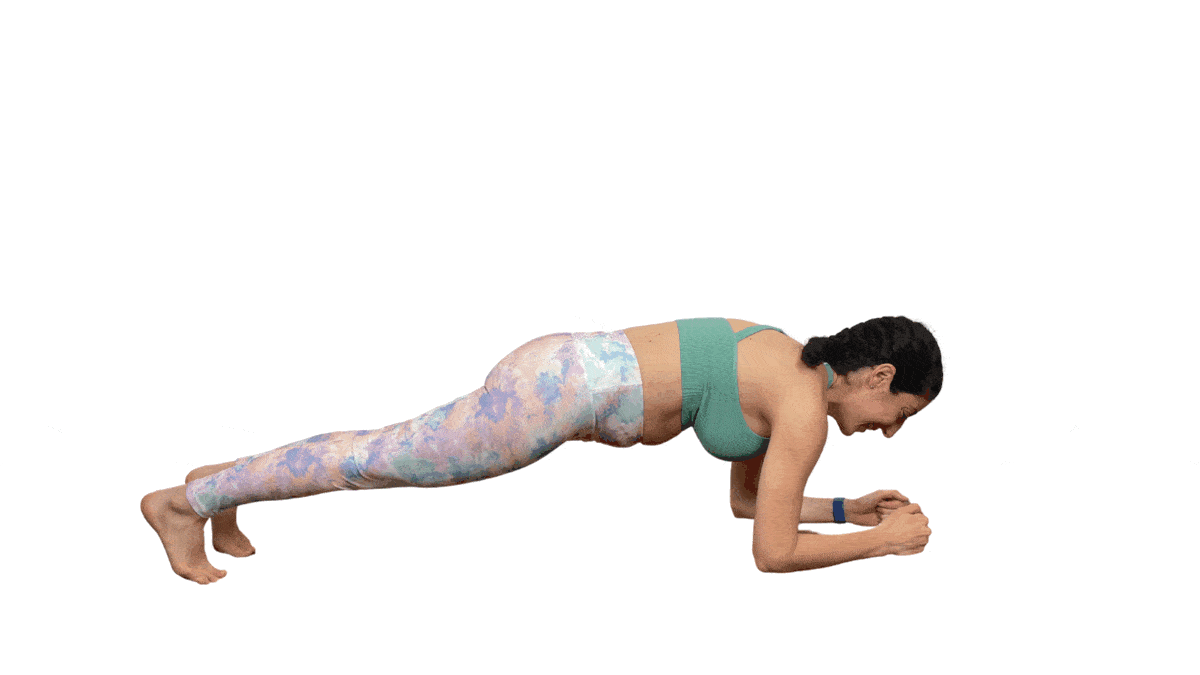
- To do it, get in a low plank position as you did before.
- From here you are going to rock your body forward and backward in a slow and controlled fashion.
- Always keep your core engaged and your glutes squeezed.
- If this is too challenging, you can do it with one knee bent on the ground.
Modified side plank (one knee bent)
The modified side plank is a great exercise to target your oblique muscles from an easier position.
During your second trimester of pregnancy, this exercise will be performed best with keeping your bottom knee in contact with the floor.
Here’s how it looks:
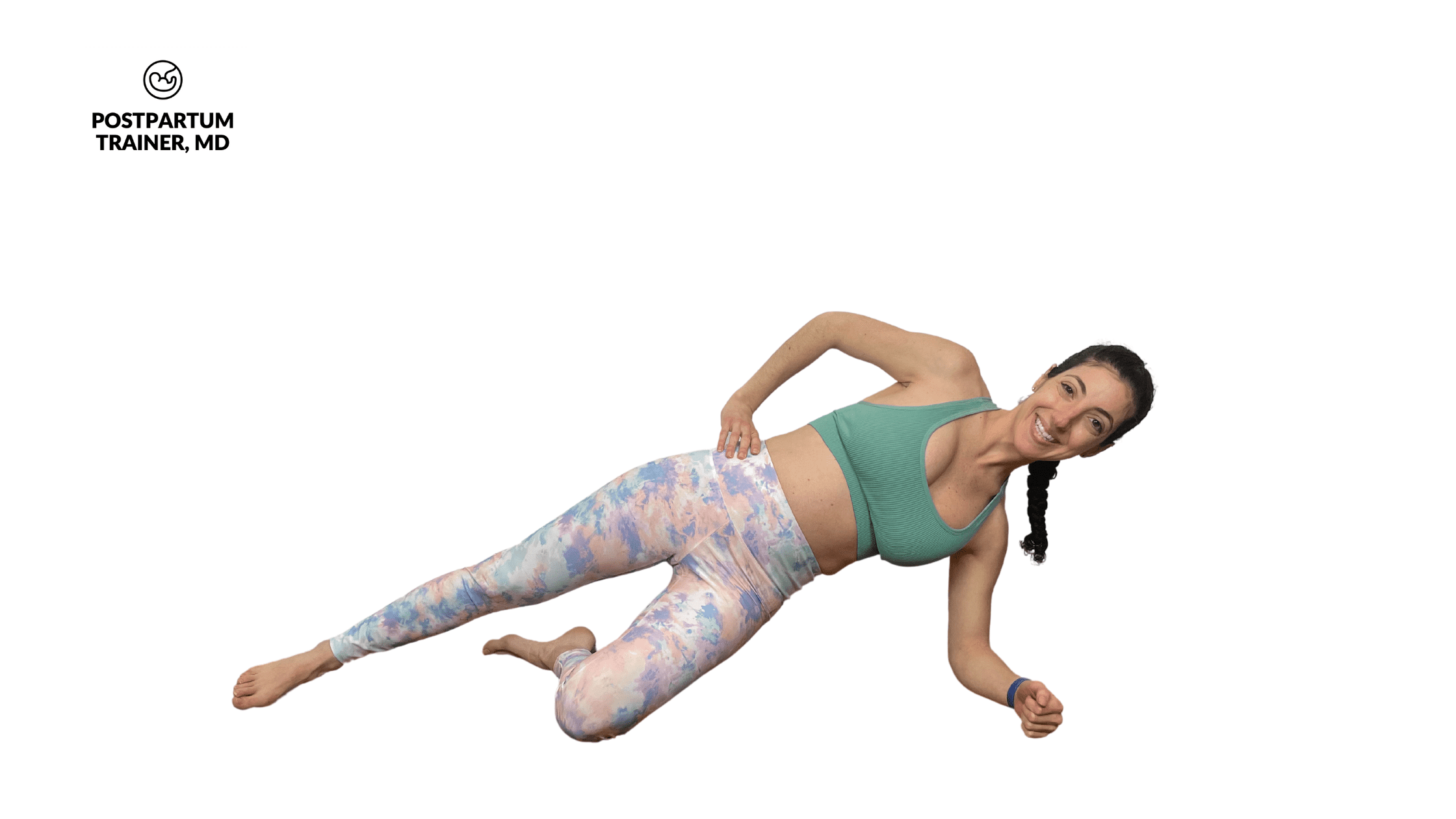
It’s done the same way as the standard side plank, except you will have one knee in contact with the floor, the entire time.
Make sure to keep your back straight, your glutes turned on, and your hips extended (don’t bend at the hips).
Hovering plank
The hovering plank is one of my favorite exercises.
Don’t underestimate it.
Just because you are on your hands and knees, the hovering plank is still very effective at targeting the rectus abdominis, and transverse abdominis muscles.
Here’s how it looks:
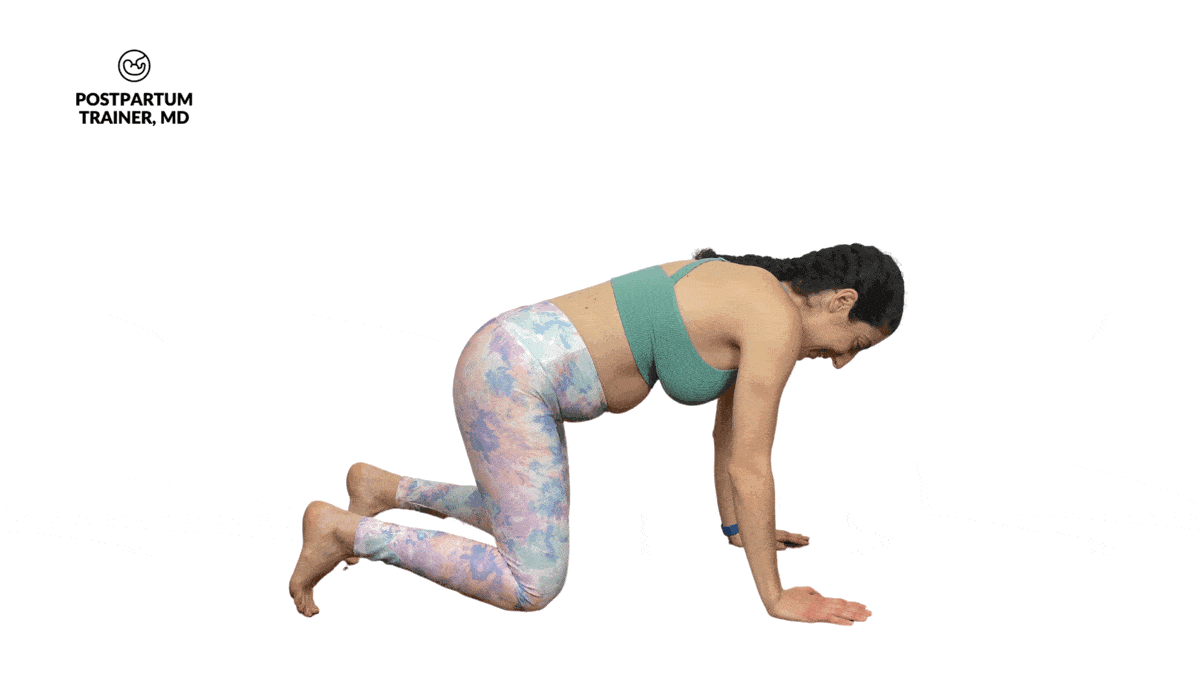
- Get into a quadruped position, on your hands and knees.
- Next, posteriorly tilt your pelvis and brace your core.
- Now you want to get on your tippy-toes without changing your spinal alignment or hand position.
- Keep your core engaged and hold this position for a 3 count.
Modified side plank with leg lift
These next two exercises add another element of difficulty to the modified side plank.
Here’s how it looks:
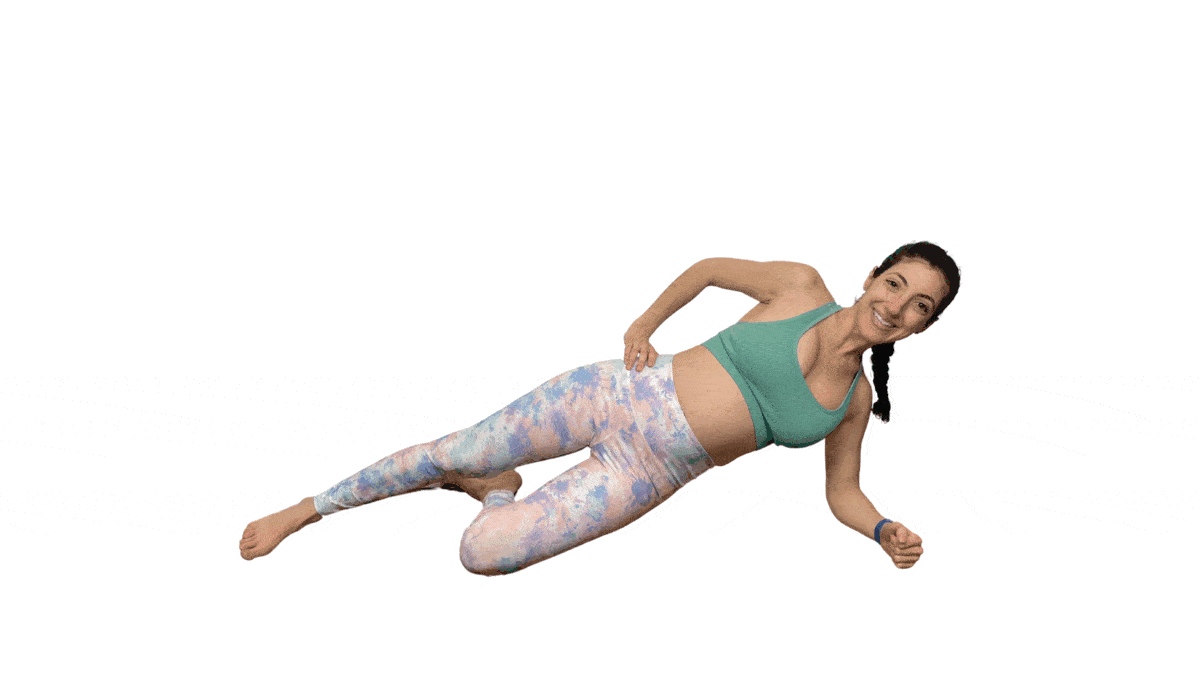
To do it:
- Get into the modified side plank as you did before.
- From here, all you have to do is lift the top leg straight up into the air.
- Keep your toes pointing forward and do not change your spinal alignment.
- Slowly lower it back down to the starting position.
Modified side plank crunch
The modified side plank crunch is similar to the leg lift, except this time you will actively side bend to engage the upper oblique muscles more.
Here’s how it looks:
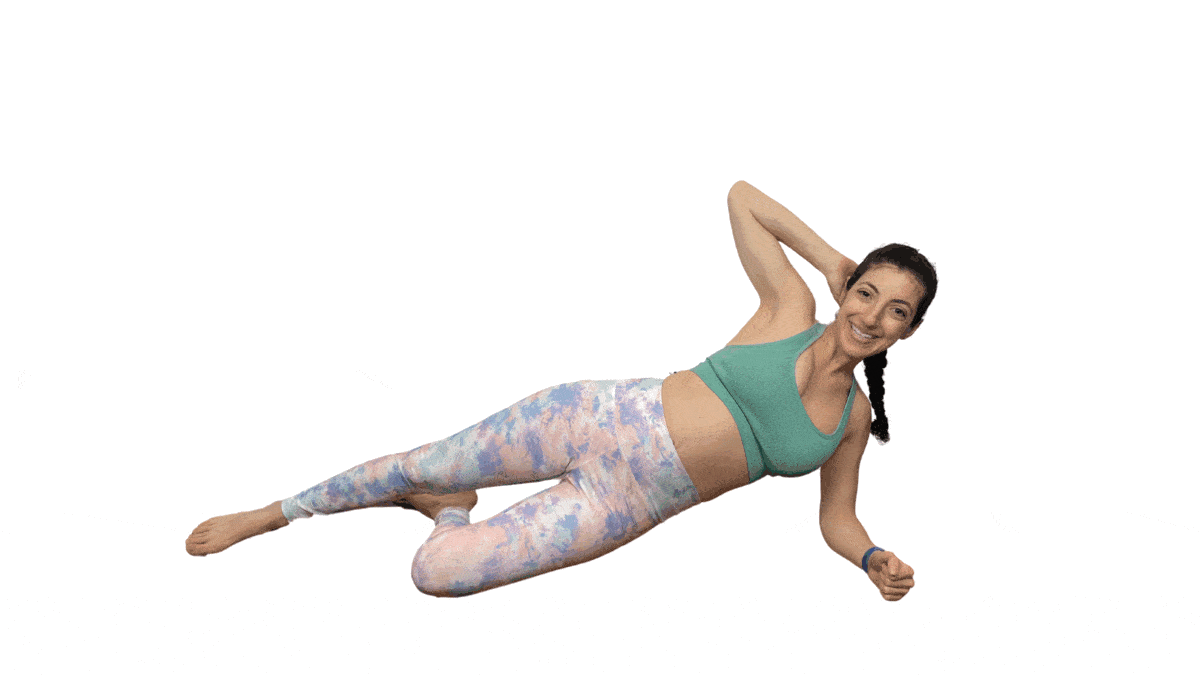
To do it:
- Get into the modified side plank as you did before, bending your top arm and placing your hand behind your head.
- From here, lift the top leg and bend your knee as you bring it up towards your head.
- Next, bend your upper torso toward your knee.
- Slowly return back to the starting position. Do this in a smooth and controlled fashion.
Incline Mountain climber
The mountain climber will strengthen the lower ab muscles while stabilizing the transverse abdominal muscles.
Here’s how it looks:
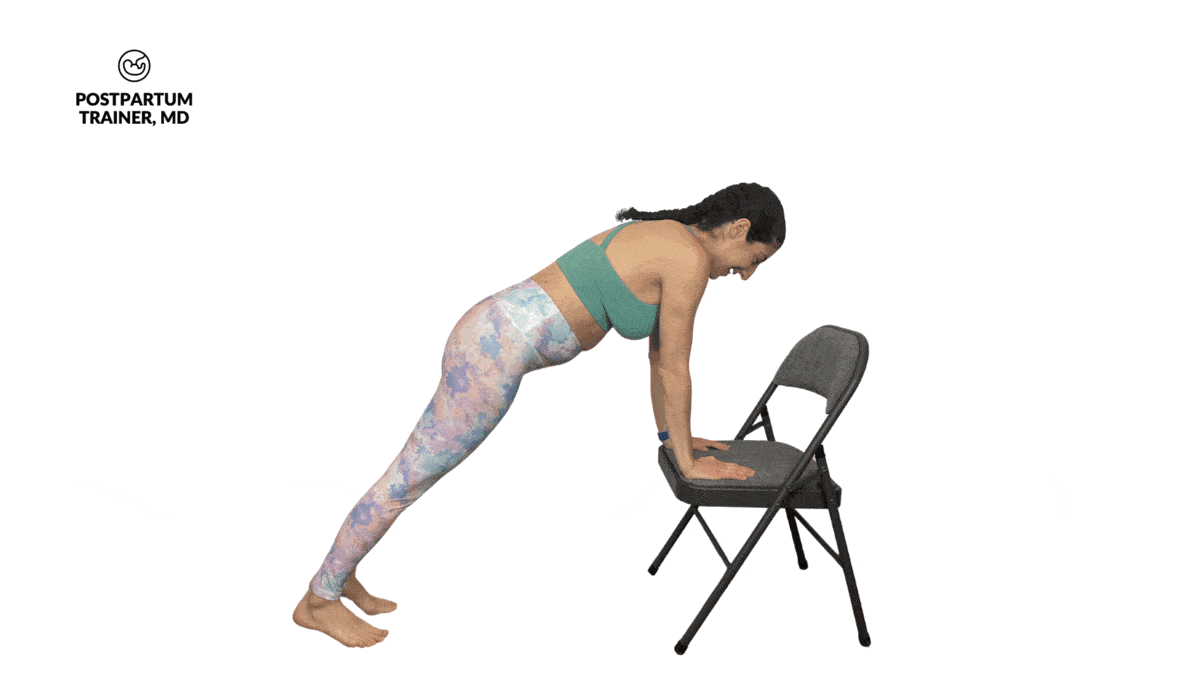
- Get into a high plank position on your hands as they rest on a chair/sofa.
- Be sure to keep your arms straight, with your hands directly underneath your elbows which should be directly underneath your shoulders.
- Maintain a straight back with your glutes and core activated.
- Now, lift your leg off the floor and bring your knee to the inside of your elbow, or as close to your elbow as possible.
- Slowly bring that knee back down and repeat on the other side.
- If this exercise is too challenging, you could perform it on an elevated surface such as a bench, chair, or sofa.
Planks During The 3rd trimester
Now we move on to the third trimester. Your belly will be much larger, and getting into these position will be much more challenging.
Here are some safe variations you can do.
High Incline Planks
The high plank is a great wait to train your abs from a safe position in the third trimester.
**Make sure that the chair is supported by a wall behind it. Never do this exercise on a free standing chair.**
Here is how it should look:
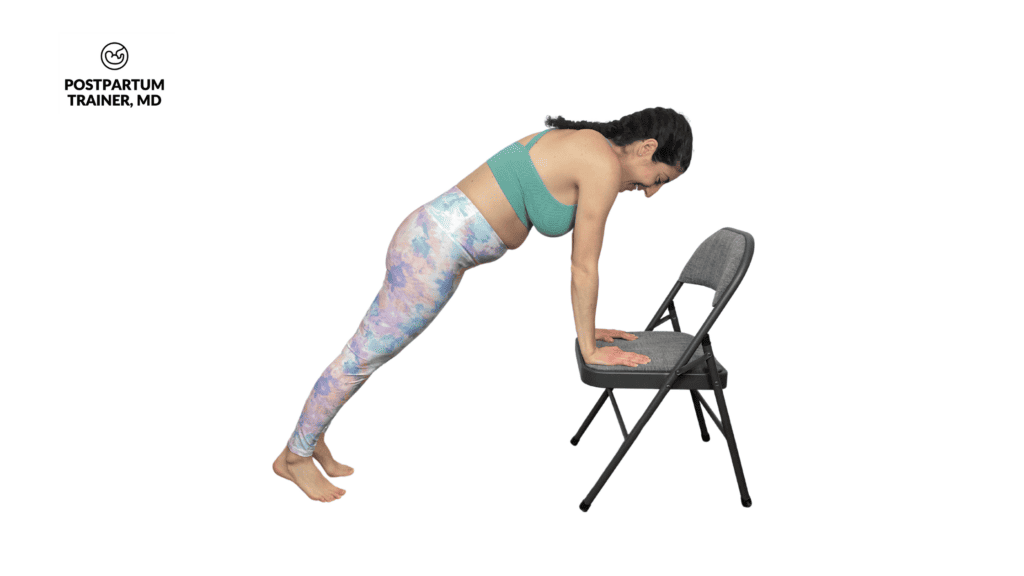
- Grab a chair, box, or sofa that you are able to lean on.
- Place your two hands on the chair, box, or sofa with straight arms.
- Step your legs out behind you and keep them straight.
- Posteriorly tilt your pelvis engaging your core and glute muscles.
Knee plank
Knee planks are a scaled back version the low plank, decreasing the demands of the movement.
Here is how it should look:
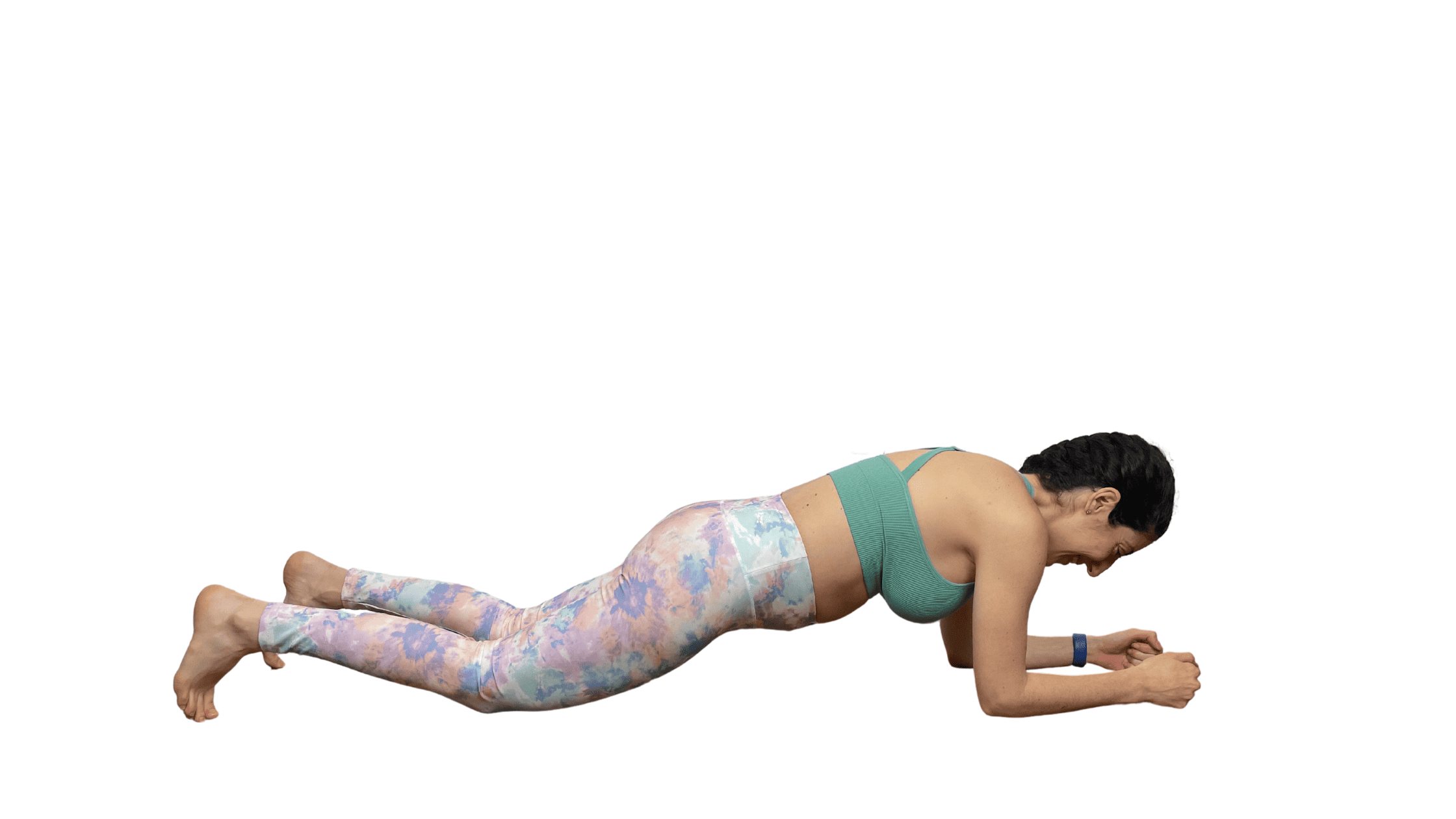
- Get into a quadruped position on your hands and knees.
- Now, straighten one knee out behind you.
- Then straighten the other knee out behind you.
- Lastly, bend one elbow down followed by the other elbow.
- From here, slowly lower your knees so that they get in contact with the floor.
- The idea is that your knees will be behind your hips, and not directly underneath them.
- Keep your core and booty muscles engaged so that your back remains neutral.
To get out of this movement simply get back into a quadruped position by bringing your knees back up closer to you.
Knee plank with shoulder taps
The knee plank shoulder tap exercise is done in the quadruped position, on your hands and knees, teaching you how to activate your rectus abdominis muscles while moving your upper body.
Here’s how it looks:
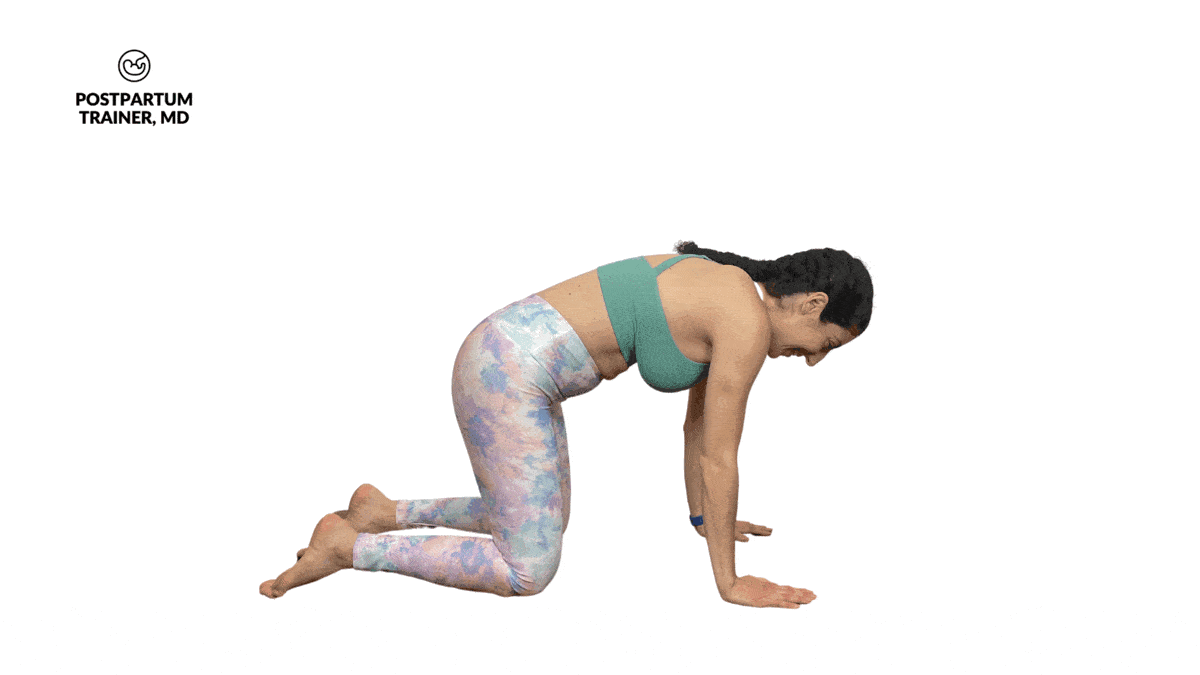
- Get into a quadruped position on your hands and knees with a flat back.
- Now posteriorly tilt your pelvis.
- Next, lift one hand off the floor and try to touch your opposite shoulder.
- Bring that hand back down to the floor and repeat with the opposite hand.
Reverse plank
The reverse plank is a quite challenging plank exercise but one that is completely safe in your 3rd trimester.
It will help strengthen your core, and glutes, and improve your shoulder flexibility.
Here’s how it looks:
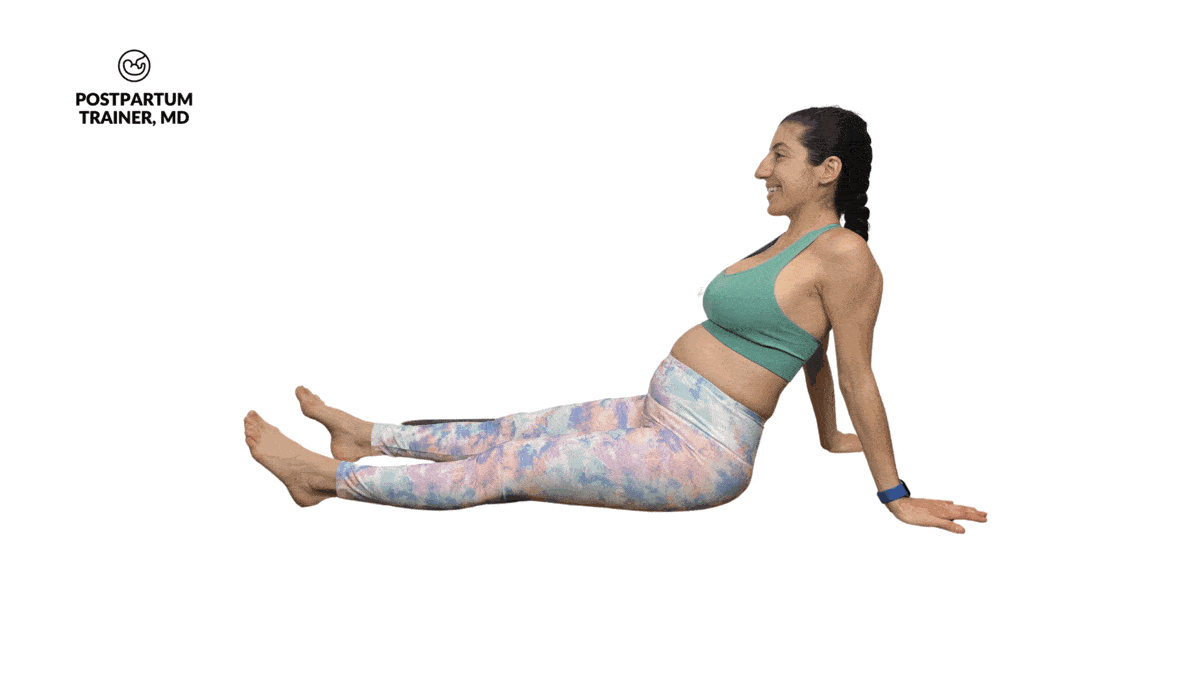
- Take a seat on the floor with your knees straight, feet flat on the floor, shoulder-width apart.
- Place your hands back behind your body with your fingers pointing back.
- Next, squeeze your glutes to extend your hips.
- Hold this position for 5-15 seconds.
- To make this movement easier, bend your knees.
Modified plank reps
The modified plank rep is a variation of the knee plank that can be performed from the high plank position or low plank position.
This movement will teach you to stabilize your core with movement.
Here’s how it looks:
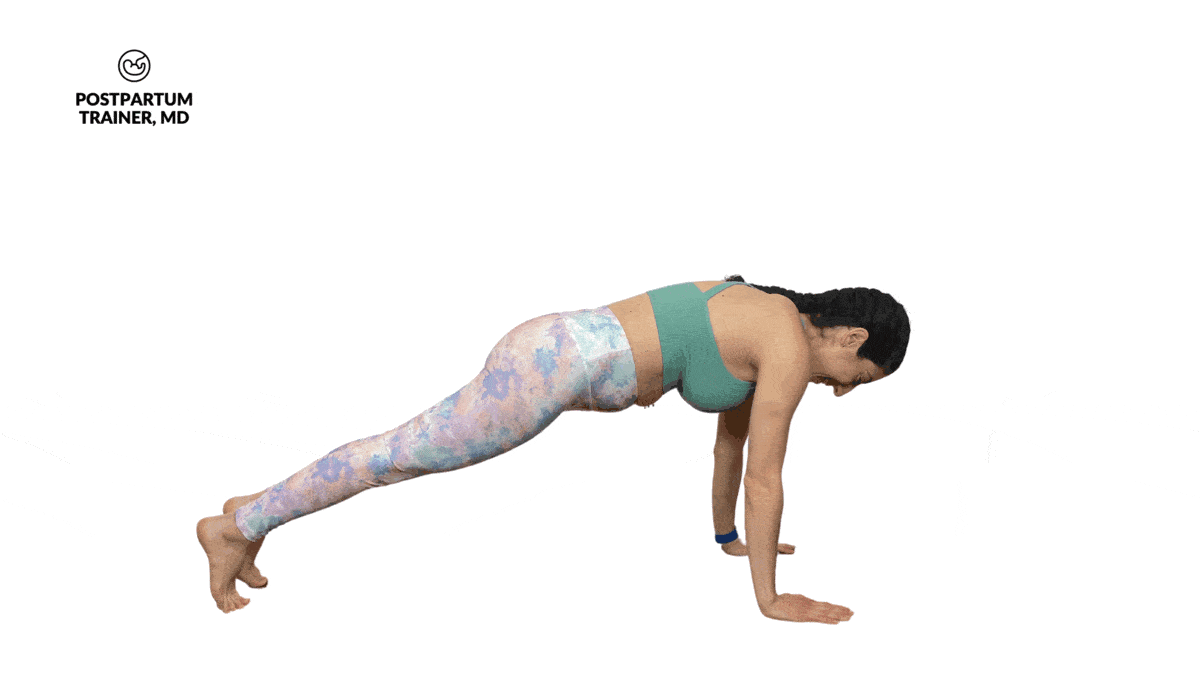
- Get into a high plank position.
- Be sure to keep your arms straight, with your hands directly underneath your elbows which should be directly underneath your shoulders.
- Maintain a straight back with your glutes and core activated.
- Now place one knee down, without making contact with the floor.
- Hold this for a 3 count.
- Next, straighten that leg and then lower the other knee without making contact with the floor.
- Keep alternating legs, while keeping your core engaged.
Modified side plank (both knees bent)
This is one of the easiest side plank variations you could perform while pregnant. You will keep both knees bent on the floor with a bent elbow.
Here’s what it looks like.
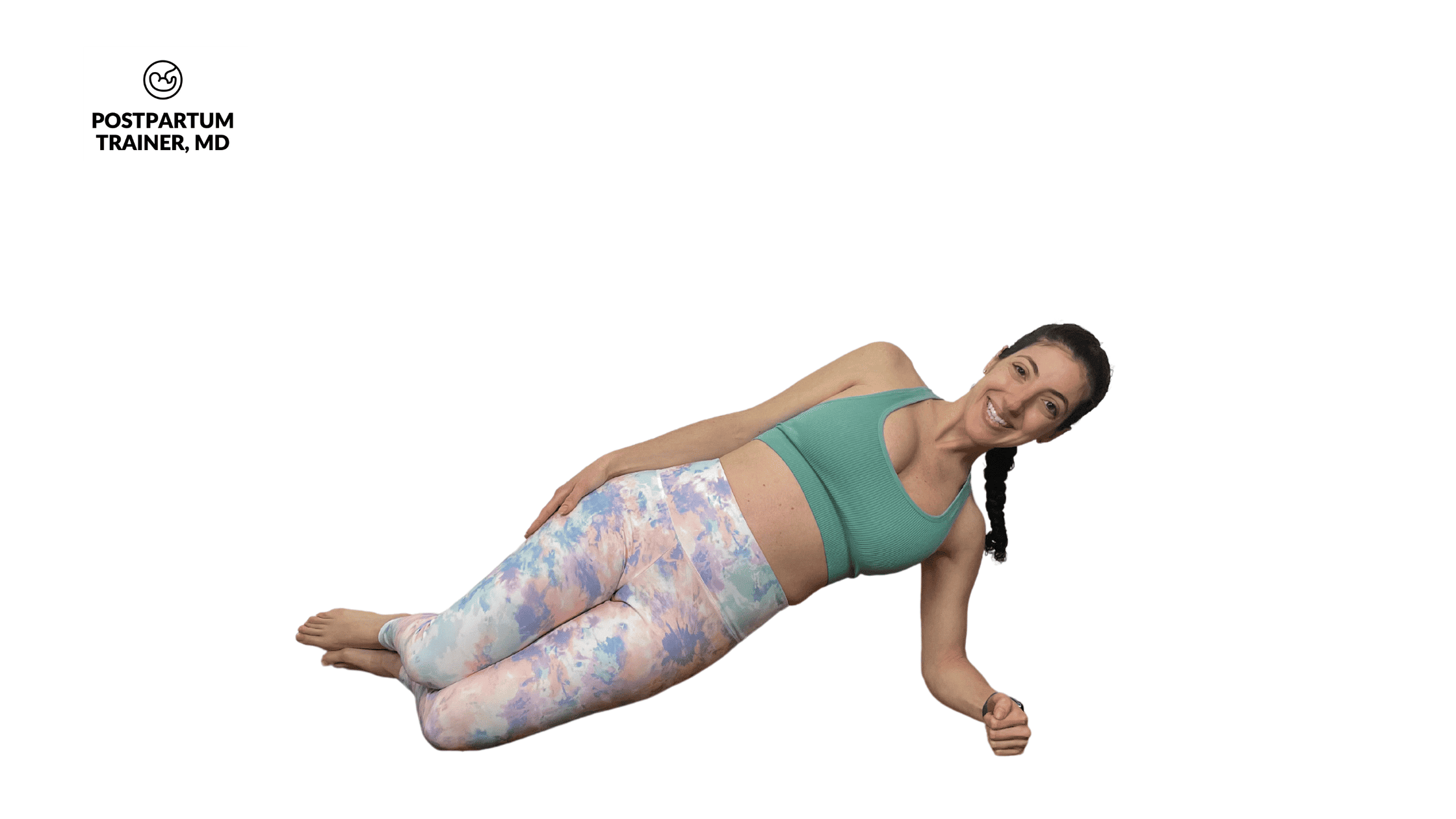
Be sure to engage your core and booty muscles to really activate the rectus abdominis, transverse abdominis, and obliques.
If this feels easy, try straightening your elbow to assume the high plank position.
Other Related Questions
Are planks safe for diastasis recti?
Modified / scaled back plank variations are safe to do with diastasis recti.
As your pregnancy progresses, your abdominal muscles get significantly weak due to the stretching they experience to accommodate the growing uterus.
This weakness in the abdominal muscles can cause you to develop the abdominal separation known as diastasis recti postpartum.
To learn more, check out these 100 exercises you can do with diastasis recti.
Can you do push-ups while pregnant?
Yes, you can do push-ups while pregnant but just like planks, you will need to modify the variation based on the trimester you are in.
Push-ups are one of the best exercises for the upper body and helps strengthen the:
- chest muscles,
- tricep muscles,
- shoulder muscles, and
- core
If you’d like to know more about push-ups in pregnancy, check out my post on Pregnancy pushups for each trimester of pregnancy.
Does bending during pregnancy affect the baby?
Excessive or sudden bending during pregnancy can theoretically affect your baby, but these are things you would be avoiding anyway.
Normal every day bending that you do in your daily life should not have any significant impact on your pregnancy as your baby is protected within the amniotic fluid.
As long as you are avoiding excessive bends, you should be okay.
This is also why we recommend that you avoid any exercises that specifically have you bending at the spine like sit-ups and crunches.
What Are Other core exercises you can do while pregnant?
Aside from planks, there are many other ways you could train your abdominal muscles from the seated, kneeling and standing position.
If you would like to learn more about these other exercises, check out:
- The 21 Best Core Exercises You Can Perform in Pregnancy
- How To Isolate The Transverse Abdominal Muscles During Pregnancy
Exercises to avoid while pregnant
In general, you should avoid any exercise that requires you to lie down flat on your back or lie down flat on your stomach.
The two major core exercises that you should avoid while pregnant are:
- Sit-ups, and
- Crunches
These place too much pressure on your abdomen and spine and increase your risk of developing back pain. That is why planks are a great substitute for sit-ups while pregnant.
Final Words On If It’s Safe To Do Abdominal Workouts When Pregnant
Training your abdominal muscles during pregnancy is safe and effective as long as you do it properly.
As with all exercise in pregnancy, make sure you have spoken with your doctor and have received medical clearance to start working out and consider doing it under the guidance of a professional.
Now I would like to hear from you.
Did you plank while you were pregnant?
What is your favorite plank and how long were you able to hold it for?
Comment below and let me know!
Related Posts On Exercising While Pregnant
- 21 Best Core Exercises For Pregnancy [How To Work Your Abs Safely]
- Can You Squat While Pregnant? [Everything You Need To Know]
- When To Start Walking During Pregnancy [What You Need To Know]
Get Four Free Workouts To Help Strengthen Your Pelvic Floor & Heal Your Mommy Tummy!

Brittany Robles, MD, MPH, CPT
Brittany Robles is a full-time OBGYN physician, a NASM certified trainer, and a prenatal and postnatal fitness specialist. She holds a Master of Public Health degree in maternal health with a special interest in exercise and nutrition. She is also the co-author of The White Coat Trainer. Learn more about her here.
Sharing is Caring – Send This To A Mom In Need!
